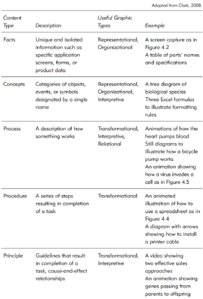Multimedia Principle: Difference between revisions
| Line 5: | Line 5: | ||
=='''Evidence'''== | =='''Evidence'''== | ||
[[File:Figure 4.7.png|thumb|250x250px|'''Figure 4.7''']] | [[File:Figure 4.7.png|thumb|250x250px|'''Figure 4.7''']] | ||
[[File:Figure 4.8.png|thumb| | [[File:Figure 4.8.png|thumb|240x240px|'''Figure 4.8''']] | ||
'''The multimedia principle does not apply equally to all learners. It works best for novices.''' (Mayer, n.d.) Here we define ‘novices’ as learners with low knowledge of the domain and ‘experts’ as learners with high knowledge of the domain. The supportive evidence is a series of three experiments involving lessons on brakes, pumps, and generators, Mayer andGallini (1990) reported that novices learned better from text and graphics (such as shown in Figure 4.8) than from words alone (such as shown in Figure 4.7). However, experts learned equally well from both conditions. | '''The multimedia principle does not apply equally to all learners. It works best for novices.''' (Mayer, n.d.) Here we define ‘novices’ as learners with low knowledge of the domain and ‘experts’ as learners with high knowledge of the domain. The supportive evidence is a series of three experiments involving lessons on brakes, pumps, and generators, Mayer andGallini (1990) reported that novices learned better from text and graphics (such as shown in Figure 4.8) than from words alone (such as shown in Figure 4.7). However, experts learned equally well from both conditions. | ||
Revision as of 18:05, 15 December 2022
Overview
The Multimedia Principle is one of Mayer's 12 multimedia learning principles that foster generative processing in the cognitive theory of learning. The Multimedia Principle states that 'learners generally benefit from the inclusion of words with graphics rather than the use of either words or graphics alone(Mayer, n.d.).' By words, we mean printed text (words displayed on the screen that people read) or spoken text (words presented as speech that people listen to through earphones or speakers). By graphics, we mean static illustrations such as drawings, charts, graphs, maps, or photos, and dynamic graphics such as animation or video. We use the term multimedia representation to refer to any presentation that contains both words and graphics. The implication of the principle through graphic inclusion should be considered carefully with the content and audience.
Evidence
The multimedia principle does not apply equally to all learners. It works best for novices. (Mayer, n.d.) Here we define ‘novices’ as learners with low knowledge of the domain and ‘experts’ as learners with high knowledge of the domain. The supportive evidence is a series of three experiments involving lessons on brakes, pumps, and generators, Mayer andGallini (1990) reported that novices learned better from text and graphics (such as shown in Figure 4.8) than from words alone (such as shown in Figure 4.7). However, experts learned equally well from both conditions.
In the study, Ollerenshaw, Aidman, and Kidd (1997) presented text lessons on how pumps work to learners who had low or high knowledge of the domain. Low-knowledge learners benefited greatly when the animation was added to the text, whereas high-knowledge learners did not. These findings prompted Kalyuga and colleagues to propose the ‘expertise reversal effect’, which holds that instructional support that benefits low-knowledge learners may not benefit (or may even harm) high-knowledge learners. Overall, instructional designers should be aware of the level of prior knowledge of their target audiences in order to provide the necessary support, such as multimedia instruction, to low-knowledge learners.
Graphics to Teach Content Types
To make the implication more effective and functional to the learners. The designer should consider the lesson content and audience based on its graphic types and content types. Lesson content can be broken down into five content types: facts, concepts, processes, procedures, and principles. Graphic types include graphics that decorate the page (decorative graphics) or simply represent a single object (representational graphics), and you incorporate graphics that help the learner understand the material (transformational and interpretive graphics) or organize the material (organizational graphics).
Selecting appropriate graphic types according to lesson content type is shown in the table.
Graphic Types:
- Decorative: Visual added for aesthetic appeal or for humor
- Representational: Visuals that illustrate the appearance of an object
- Organizational: Visuals that show qualitative relationships among content
- Relational: Visuals that summarize quantitative relationships
- Transformational: Visuals that illustrate changes in time or over space
- Interpretive: Visuals that make intangible phenomena visible and concrete




